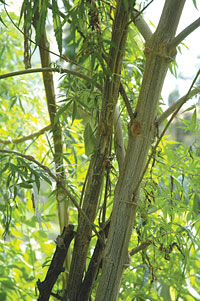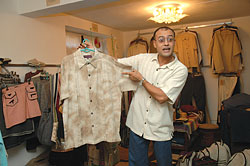 It's called weed because it grows everywhere. Fuel, food and fabric can be obtained from the Cannabis plant and cultures the world over have been using it for such purposes for thousands of years. Nepali villagers are no different but authorities here have ignored traditional culture and see Cannabis only as an enemy in a 'war on drugs'.
It's called weed because it grows everywhere. Fuel, food and fabric can be obtained from the Cannabis plant and cultures the world over have been using it for such purposes for thousands of years. Nepali villagers are no different but authorities here have ignored traditional culture and see Cannabis only as an enemy in a 'war on drugs'.
Many other countries, including China, the UK, Canada, India and even several US states have already legalised the production of Cannabis for commercial and medical purposes and are reaping huge benefits as a result. Nepal has one of nature's best varieties of the plant, but it's illegal to grow Cannabis here because it is known more for its psychoactive properties as 'ganja'. Cannabis Sativa, one of the most useful species, grows naturally from Mahakali to Mechi and Nepal's Himalayan climate allows for three crops a year while most other hemp harvesting nations can only manage two.
Admittedly, Nepal's Cannabis Sativa is famous among marijuana users worldwide for its natural high and unique flavour but it is not just a product of the flower-power generation when hippies flocked to their Mecca-Nepal -because Nepalis have also been using hemp, the fibre derived from the Cannabis plant, for eons.  Among the rural folk of the western hills of Bajura, Bajhang, Rolpa, Rukum and Darchula, hemp collection is an important pastime. Shepherds spin the fibre into thread while grazing their sheep and cattle.
Among the rural folk of the western hills of Bajura, Bajhang, Rolpa, Rukum and Darchula, hemp collection is an important pastime. Shepherds spin the fibre into thread while grazing their sheep and cattle.
Cannabis plants grow to a height of 20 ft. After harvesting them, villagers shred the leaves and soak the stems in water for up to 20 days. When they are tender the bark is separated from the rest of the plant, smoked above a fire and boiled in ash water. Thin strips are then removed from the bark by hand.
"The older generation used to have holes in their thumbnails through which they passed the strips of fibre and wove them to make thread," says Prem Dahal, proprietor of Hemp House. Dahal has been in the hemp business for over 19 years and is one of few who still use Nepali hemp for his products, even after the emergence of Chinese hemp in the market.
Dahal buys Rs 3-4 million worth of raw hemp every year from villagers who travel to sell it in Kathmandu. "I have to buy whenever they come because you can never tell when they will have the chance to come back," says Dahal. He explains that the growth of the carpet business in the last five years boosted the price of hemp from just Rs 100 to Rs 300-400 a kg. Dahal exports his products, such as clothes, bags, cushion covers and small carpets, to seven countries and estimates that Nepal's hemp business is worth up to Rs 800-900 million a year.
Another anchor on the industry's growth is the poor reputation of Nepali hemp in the international market. There are two reasons for that: pure Nepali hemp is too roughly woven to be used in fabric, and so most producers here use low grade Chinese hemp bought in Khasa, then mix it with Nepali fibre, which eventually gives Nepali hemp a bad name in the international market. "The problem with Nepali hemp is that we have not been able to produce fine quality thread because of the lack of investment," says Dahal.
Although hemp comprises only a small fraction of the international textile market, there is growing awareness of fibre. But here, neither the government nor the private sector, such as the Garment Association of Nepal (GAN), have shown much interest in the possibilities. The fact remains that GAN does not collect statistics on how much hemp products are shipped overseas, and their grouping of hemp together with nettle exports shows their lack of concern for this sector.
"It is possible to produce top quality fabric from Nepali hemp but because it's illegal no one wants to invest," says Udaya Shamsher Thapa of Heaven Hemp, who has been exporting clothes made from Nepali hemp for several years now.
 Willing investor
Willing investor Because Nepali hemp is collected seasonally, exporters of hemp products cannot count on a sure supply of the material. That's the reason Sophia KC of Basu's Export House, the country's biggest importer, decided to switch to Chinese hemp to make her products. Sophia imports 8,000-10,000 kgs of Chinese hemp two-three times a year, mixing it with Nepali hemp to make different types of fabric. She says she would like to use Nepali hemp and is even willing to invest in producing high quality fabric and says "There were just too many obstructions. If it could be legalised there are plenty of willing investors and it will benefit a lot of people."


